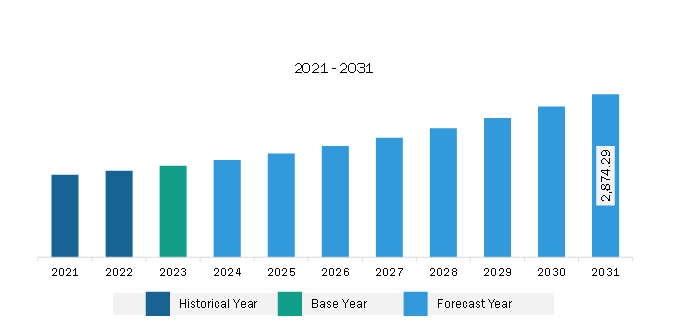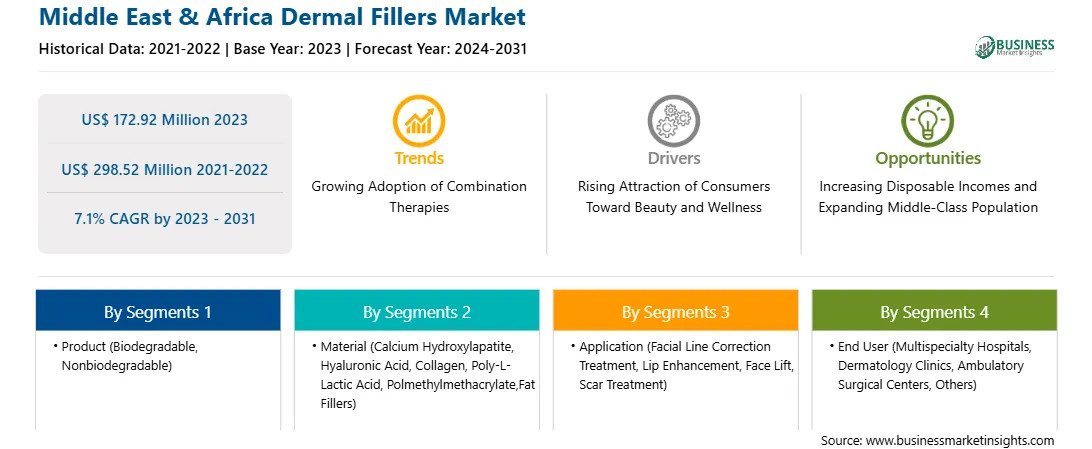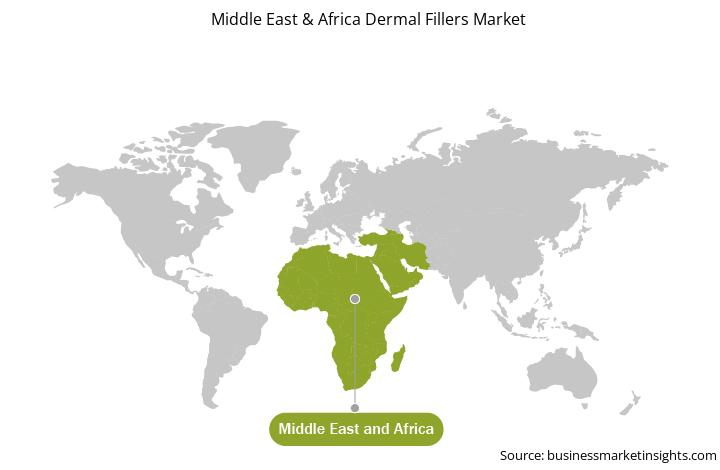The Middle East & Africa dermal fillers market was valued at US$ 172.92 million in 2023 and is expected to reach US$ 298.52 million by 2031; it is estimated to register a CAGR of 7.1% from 2023 to 2031.
The requirement for personalized treatments, comprehensive results, and minimally invasive options results in a high preference for combination therapies. These therapies involve the use of multiple treatment modalities or products to achieve better results over a single therapy. Dermal fillers can be combined with botox, chemical peels, laser resurfacing, and microneedling. For instance, dermal fillers combined with botox have become a popular choice for facial rejuvenation, as this combination can effectively address various indications of aging. Dermal fillers enhance the skin, whereas botox relaxes the muscles that create wrinkles and lines. Together, they create a more complete metamorphosis, resulting in a smoother, more youthful appearance. The combined benefits are also more long-lasting than when the treatments are performed separately, as dermal fillers can aid in supporting botox's effects. Furthermore, combining dermal fillers and platelet-rich plasma (PRP) therapy helps stimulate the production of collagen and elastin proteins that are important for repairing skin. According to the Beautiful Orlando Medical Spa, combining PRP and dermal fillers, such as hyaluronic acid filler, helps in longevity and enhances results. Dermal filler helps restore the skin areas that have lost volume over time. The addition of PRP helps in stimulating the body's regenerating mechanism. PRP can also cure skin conditions that fillers cannot, such as uneven texture and tones. Thus, the trend of combination therapies is expected to benefit the Middle East & Africa dermal fillers market performance by unlocking advantages such as high-quality results for skin with lower pain and recovery time.
The Middle East & Africa dermal fillers market is segmented into Saudi Arabia, the UAE, South Africa, and the Rest of Middle East & Africa. The market in these countries is experiencing significant growth due to increasing awareness of cosmetic procedures and the rising demand for noninvasive treatments. Also, the increasing adoption of cosmetic treatments among the young population and advances in dermatology are expected to create opportunities for the Middle East & Africa dermal fillers market during the forecast period.

Strategic insights for the Middle East & Africa Dermal Fillers provides data-driven analysis of the industry landscape, including current trends, key players, and regional nuances. These insights offer actionable recommendations, enabling readers to differentiate themselves from competitors by identifying untapped segments or developing unique value propositions. Leveraging data analytics, these insights help industry players anticipate the market shifts, whether investors, manufacturers, or other stakeholders. A future-oriented perspective is essential, helping stakeholders anticipate market shifts and position themselves for long-term success in this dynamic region. Ultimately, effective strategic insights empower readers to make informed decisions that drive profitability and achieve their business objectives within the market.

| Report Attribute | Details |
|---|---|
| Market size in 2023 | US$ 172.92 Million |
| Market Size by 2031 | US$ 298.52 Million |
| Global CAGR (2023 - 2031) | 7.1% |
| Historical Data | 2021-2022 |
| Forecast period | 2024-2031 |
| Segments Covered |
By Product
|
| Regions and Countries Covered | Middle East and Africa
|
| Market leaders and key company profiles |
The geographic scope of the Middle East & Africa Dermal Fillers refers to the specific areas in which a business operates and competes. Understanding local distinctions, such as diverse consumer preferences (e.g., demand for specific plug types or battery backup durations), varying economic conditions, and regulatory environments, is crucial for tailoring strategies to specific markets. Businesses can expand their reach by identifying underserved areas or adapting their offerings to meet local demands. A clear market focus allows for more effective resource allocation, targeted marketing campaigns, and better positioning against local competitors, ultimately driving growth in those targeted areas.

The Middle East & Africa Dermal Fillers Market is categorized into product, material, application, end user, and country.
Based on product, the Middle East & Africa Dermal Fillers Market is bifurcated biodegradable and nonbiodegradable. The biodegradable segment held a larger market share in 2023.
In terms of material, the Middle East & Africa Dermal Fillers Market is categorized calcium hydroxylapatite, hyaluronic acid, collagen, poly-l-lactic acid, polmethylmethacrylate (PMMA), fat fillers, and others. The hyaluronic acid segment held the largest market share in 2023.
By application, the Middle East & Africa Dermal Fillers Market is segmented into facial line correction treatment, lip enhancement, face lift, scar treatment, and others. The lip enhancement segment held a larger market share in 2023.
By end user, the Middle East & Africa Dermal Fillers Market is segmented into multispecialty hospitals, dermatology clinics, ambulatory surgical centers, and others. The dermatology clinics segment held a larger market share in 2023.
By country, the Middle East & Africa Dermal Fillers Market is segmented into South Africa, Saudi Arabia, the UAE, and the Rest of Middle East & Africa. The South Africa dominated the Middle East & Africa Dermal Fillers Market share in 2023.
AbbVie Inc, Galderma SA, Merz Pharma GmbH & Co KGaA, Prollenium Medical Technologies, Sinclair Pharma Ltd, Suneva Medical, and TEOXANE LABORATORIES are among the leading companies operating in the Middle East & Africa Dermal Fillers Market.
The Middle East & Africa Dermal Fillers Market is valued at US$ 172.92 Million in 2023, it is projected to reach US$ 298.52 Million by 2031.
As per our report Middle East & Africa Dermal Fillers Market, the market size is valued at US$ 172.92 Million in 2023, projecting it to reach US$ 298.52 Million by 2031. This translates to a CAGR of approximately 7.1% during the forecast period.
The Middle East & Africa Dermal Fillers Market report typically cover these key segments-
The historic period, base year, and forecast period can vary slightly depending on the specific market research report. However, for the Middle East & Africa Dermal Fillers Market report:
The Middle East & Africa Dermal Fillers Market is populated by several key players, each contributing to its growth and innovation. Some of the major players include:
The Middle East & Africa Dermal Fillers Market report is valuable for diverse stakeholders, including:
Essentially, anyone involved in or considering involvement in the Middle East & Africa Dermal Fillers Market value chain can benefit from the information contained in a comprehensive market report.